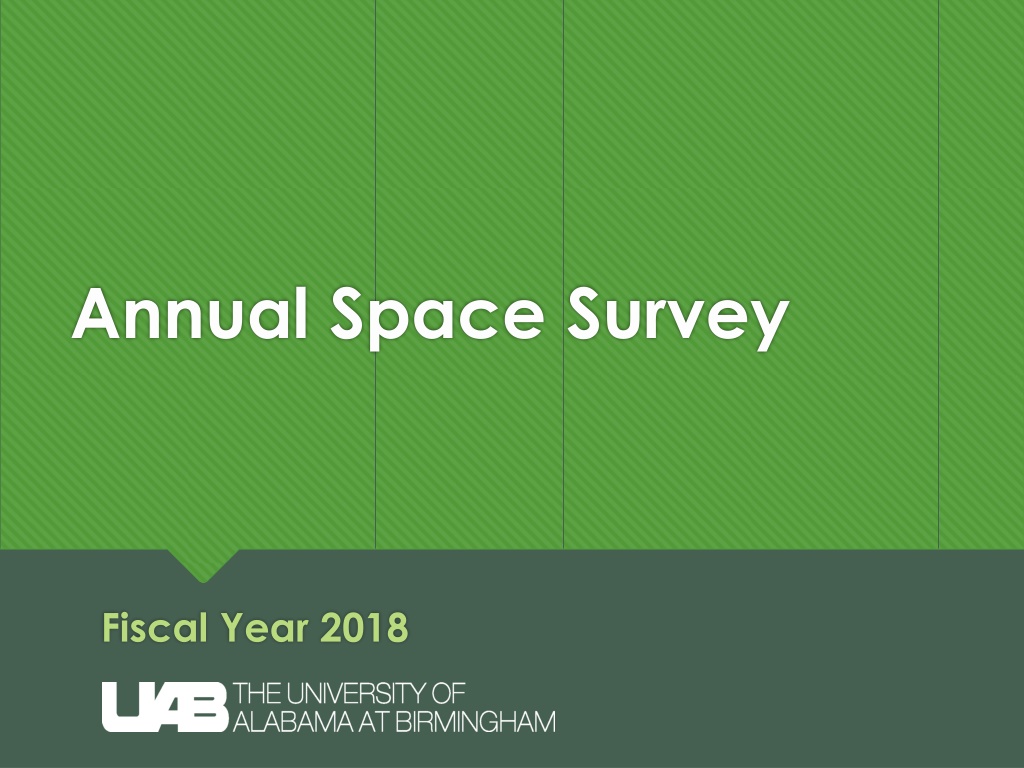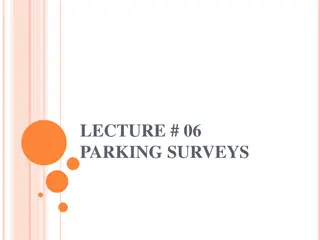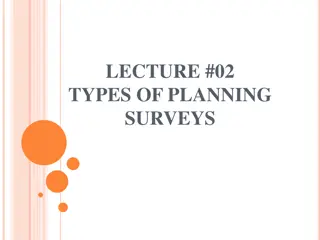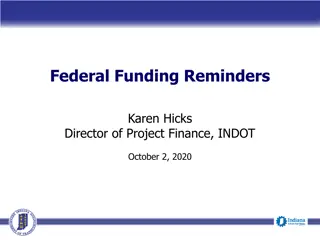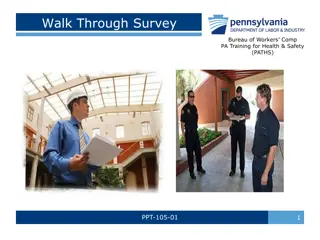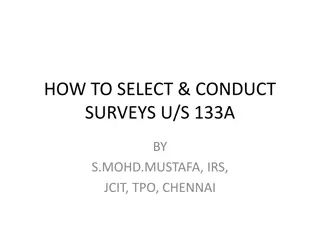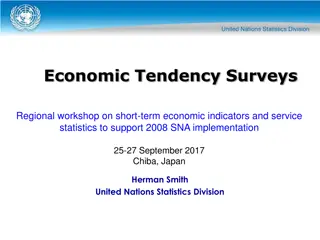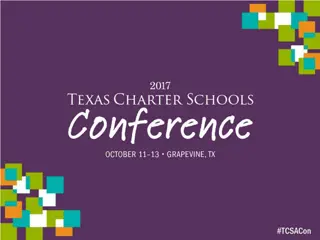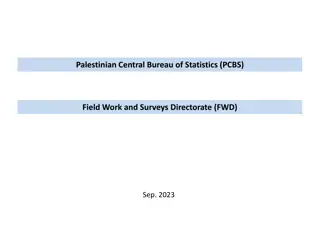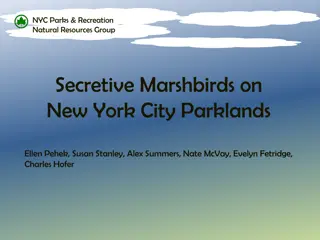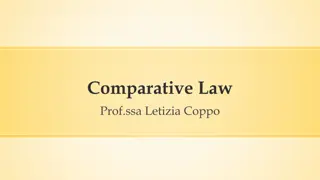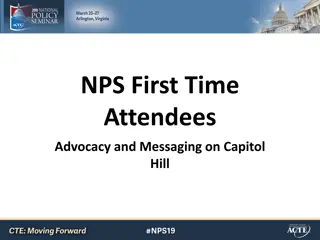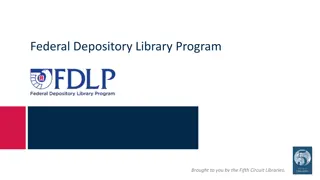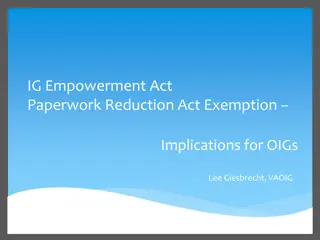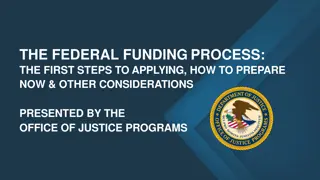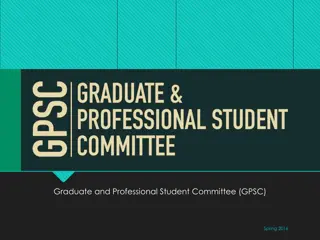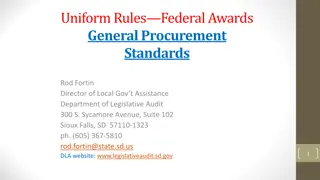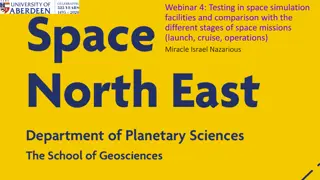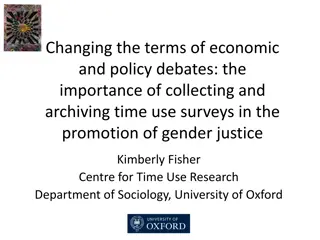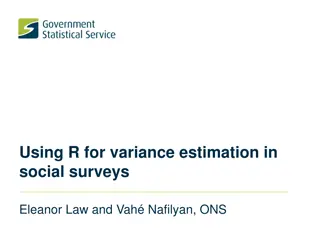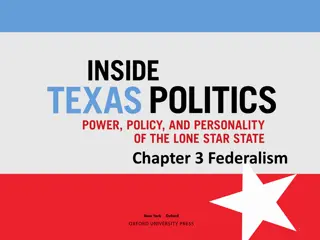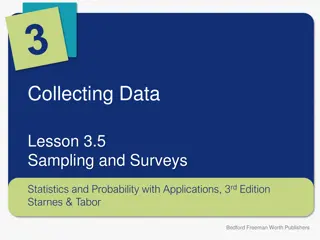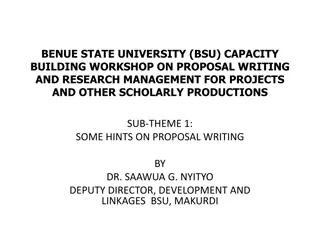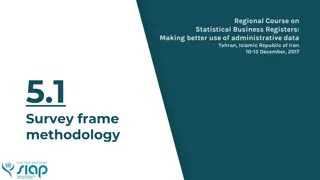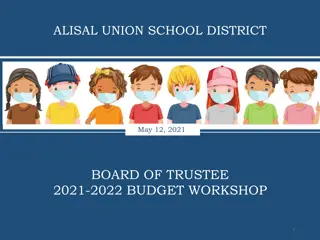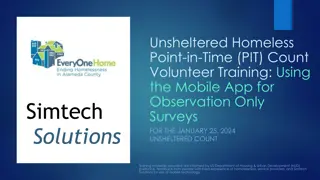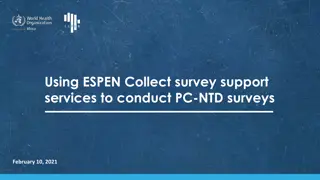Understanding the Importance of Space Surveys for Federal Funding
A space survey is crucial for universities like UAB as it determines the allocation of facilities costs, impacting F&A rate reimbursement for research. Detailed space usage statistics are essential for federal review, affecting the financial resources of the institution significantly.
Download Presentation

Please find below an Image/Link to download the presentation.
The content on the website is provided AS IS for your information and personal use only. It may not be sold, licensed, or shared on other websites without obtaining consent from the author. Download presentation by click this link. If you encounter any issues during the download, it is possible that the publisher has removed the file from their server.
E N D
Presentation Transcript
Annual Space Survey Fiscal Year 2018
Overview Introduction Background Space Study Procedures Functional Definitions Determining Functional Usages/Room Type Guidelines Frequently Asked Questions Potential Federal Review
Background Why is a Space Survey Important? The facilities component of UAB s F&A rate is allocated based on the results of the survey (i.e. square footage statistics). The facilities component is the only uncapped portion of the F&A rate (i.e. the only area where UAB has the potential to increase it s reimbursement of costs associated with conducting research). For buildings with more than one function, Federal regulations require the allocation of facilities costs based upon functional use of space. Federal regulations require the allocations to be appropriately documented in sufficient detail for subsequent review by the cognizant federal agency.
Background Why is a Space Survey Important? Facilities related costs represent a major component of the Organized Research rate Space Survey is the statistic that allocates the facility related costs Critical component of the rate proposal
Background What are the Space Survey Objectives? Specific Goals: Identify all activities performed in each room for reasonable cost allocations. Develop proposal statistics that are defensible during rate negotiations with the federal government. Use methodologies that comply with government requirements and that provide the best cost recoveries. The functional space survey is subject to review/audit by the federal cognizant agency (HHS).
Background What Impact Will You Have? The quality of your response determines the accuracy and defensibility of the allocation of costs in the F&A Rate Proposal. The allocation of costs determines the final F&A Rate computed and submitted to the Federal Government for negotiation. The accuracy and defensibility of the F&A Rate Proposal submission determines the ultimate success of UAB in maintaining and/or enhancing it s current F&A rate. The final F&A rate negotiated determines the amount of money recovered by UAB to support the current and future resource requirements of the research enterprise. IN SHORT, YOUR EFFORT WILL IMPACT THE FINANCIAL RESOURCES OF THE UNIVERSITY!
Background What Impact Will You Have? Why conduct a Space Inventory and Functional Usage Study? F&A Cost Reimbursement Uniform Guidance Must identify research space in specific percentage terms. Cannot use predominant use.
Background F&A Proposal Structure Direct Costs F& A Costs Indirect costs incurred to support Costs incurred in performing Research activities: Research activities: Depreciation of Research Buildings Salaries and Fringe Benefits of Lab Personnel & Equipment Research Supplies and Materials Operation & Maintenance of Travel Research Areas Consultant Services Construction Interest of Research Areas Administrative Services $48,500,000 $100,000,000 F&A Costs Direct Costs F & A Cost Rate = 48.5%
Background F&A Cost Pools Pools Allocation Statistics Facilities Square Footage Square Footage Square Footage Square Footage Student, Faculty, Staff FTE Buildings Equipment Operation & Maintenance Interest Expense Library Administrative General Administration Dept. Administration Sponsored Projects Admin. Student Admin. & Services MTDC MTDC MTDC Allocated to Instruction
Space Survey Procedures How Do I Complete the Space Survey? INSITE a web-based survey manager application for completing the space survey Validate room demographic information Document the functional usage (activity) taking place in the room Document the functional usage percentage of Patient Care activity (P-HSF, P-HOSP, P-PAT, P-CEFH, P-CH, P-DFP, P-OSF, P-SHC, P-SPC, P-UOG, P-VA, P-VALLEY) for Joint Use spaces please document in the comments section. List accounts (source of funding) for the activity in rooms with sponsored activity List all room occupants performing activity in rooms with sponsored activity
Space Survey Procedures Critical Success Factors First hand knowledge of how the space was used during fiscal year 2018 (10/01/2017 09/30/2018) An understanding of the activities performed in the room Information on funding sources related to the activities for the space (grants, contracts, departmental funds, etc.) Knowledge of the space and occupants of the space may need to contact/meet PI s to gather necessary information
Space Survey Procedures Validating Room Demographic Information Review room list for accuracy and completeness Rooms used by department during FY 2018 missing from list Rooms on list not used by department during FY 2018 Rooms that have physically changed Identify Faculty Offices through change of use Identify Responsible Person Identify Principal Investigator (now mandatory) Confirm that room type is accurate
Space Survey Procedures Documenting Rooms Where Sponsored Activity Is Taking Place IDENTIFY PERSONNEL List ALL personnel who occupied each room on a regular basis during Fiscal Year 2018 (e.g. Faculty, Research Staff, Post Docs, Technicians, Graduate Students, Undergraduate Students, Visiting Scientists) INSITE functionality easily see, select and assign names of personnel paid by your department List any unpaid occupants in the occupant comments section
Space Survey Procedures Documenting Rooms Where Sponsored Activity is Taking Place IDENTIFY SPONSORED AWARDS Identify the grant award numbers of the projects performed in each room during Fiscal Year 2018 INSITE functionality easily see, select and assign grants awarded to PI s in your department
Space Survey Procedures Determine Functional Usage Space should be functionalized based on the activities performed in the area When space is occupied by multiple individuals the frequency and intensity of their presence should be considered in determining the percentage of functional activity
Functional Definitions Joint Use (J-JT) This category includes space used for conference rooms and other multi-function rooms, such as copy rooms, employee lounges, and departmental libraries. Offices and office service areas should also be coded to Joint Use. Departments should not enter this function into any of their spaces. Joint Use spaces are pre-populated and the system will not allow a change of function in those spaces. This is for Cost Analysis use only. Departments do not need to identify occupants or accounts for Joint Use spaces. If there are any of the following activities occurring in joint use spaces please note the activity and the percentage in the comments section: Service Center, Patient Care, Vacant or Under Renovation.
Listing of Joint Use (J-JT) Room Types: Communications Room Communications Room Service Office Kitchen Office Service Conference Room Other Special Uses Conference Room Service Processing Room Data Processing/Computer Reading Study Room Data Processing/Computer Service Reading/Study Room Service Demonstration Receiving Demonstration Service Seminar Room Independent Study Lab Seminar Service Independent Study Lab Service Shop Lounge Shop Service Lounge Service Study Service Meeting Room Unit Storage / Lab Storage Meeting Room Service Waste Storage Office / Faculty Office Waste Storage Service
Functional Definitions Organized/Sponsored Research (R-RSCH) This category includes all research and development activities of the University that are separately budgeted and accounted for on a specific project basis, and research cost sharing. Organized research activities include: SponsoredResearch Projects: Research projects sponsored by Federal agencies and non-Federal organizations (e.g. states, cities, foundations, corporations, etc.) through grants, contracts, and cooperative agreements. Clinical Trials/Drug Studies: Generally Phase 1 activities involving drug development and sponsored by Federal agencies and non- Federal organizations (e.g. states, cities, foundations, pharmaceutical companies, etc.)
Functional Definitions Organized/Sponsored Research (R-RSCH) continued SponsoredResearch Training: The training of individuals in research techniques sponsored by Federal agencies and non- Federal organizations through grants, contracts and cooperative agreements. Common examples include Career Development ( K ) awards, institutional training grants (T-32), individual fellowships (F-32), etc. University Research Projects: Research projects funded with University funds that are separately budgeted and accounted for on a specific project basis. Research Cost Sharing: Cost sharing related to organized research projects
Functional Definitions Instruction/Departmental Research (I-INST) This category includes all non-sponsored teaching and training activities. Teaching and Training: All regular University teaching and training activities, whether they are offered for credits toward a degree or certificate or on a non-credit basis. Includes classroom teaching, preparing instructional materials, preparing and grading examinations, etc. Departmental Research: Research, development and scholarly activities that are not separately budgeted and accounted for on an individual project basis. It is research conducted by an individual that is not associated with any particular sponsored research project. It is supported by departmental funds, gift accounts and start-up funds that the University has discretion on how the funding can be utilized.
Functional Definitions Sponsored Instruction / Training (S-INST) Instructional or training activities sponsored by Federal agencies and non-Federal organizations through grants, contracts, and cooperative agreements. This category does not include Research Training activities.
Functional Definitions Other Sponsored Activities (O-OSA) Other sponsored activities are programs and projects financed by Federal and non-Federal agencies and organizations that involve the performance of work other than instruction and organized research. Examples are health service projects, public service projects, public service conferences, and Phase 2, 3, and 4 clinical trials involving the patient testing of drugs.
Functional Definitions University Hospital Patient Care (P-HOSP) This category includes the direct and supportive health care activities (prevention, diagnosis, treatment, counseling, rehabilitation, etc.) conducted under the control and authority of the University of Alabama Hospital (not including Health Services Foundation activities, Children s Hospital, Callahan EFH or Veteran s Administration Medical Center Activities). These activities result in individuals being seen, treated, or counseled or having their cases discussed with other practitioners for the purpose of health care or diagnosis and not as subjects of research projects. Supportive activities include patient scheduling, patient records, patient correspondence, patient billing, and other related activities.
Functional Definitions Health Services Foundation (P-HSF) Included here are billable health care activities conducted under the control and authority of the Health Services Foundation. Activities include both direct patient contact and supportive activities such as patient scheduling, patient records, patient correspondence, patient billing and other related activities conducted in all UAB and/or UAB leased buildings. Please list the percentage of HSF activities for Joint Use (J-JT) spaces in the comments section of the survey form.
Functional Definitions Patient Services Included here are billable health care activities conducted under the control and authority of affiliated units/organizations other than University Hospital and the Health Services Foundation. Activities include both direct patient contact and supportive activities such as patient scheduling, patient records, patient correspondence, patient billing and other related activities. Callahan Eye Foundation Hospital (P-CEFH) Children s Hospital (P-CH) Dentistry Private Faculty Practice (P-DFP) Optometry Private Faculty Practice (P-UOG) Sparks/CDLD Clinics (P-SPC) Speech and Hearing Clinic (P-SHC) Veteran s Administration Medical Center (P-VA) University Ophthalmology Service Foundation (P-OSF) Huntsville Valley Foundation (P-VALLEY) Please list the percentage of Patient Services activities for Joint Use (J-JT) spaces in the comments section of the survey form.
Functional Definitions Patient Care UAB Hospital (P-PAT) This category includes those activities involved with the delivery of patient care (e.g., University Medical Center and clinics). The space associated with residents in the School of Medicine should be coded as P-PAT. Also includes the space devoted to the CCTS including all administrative and support areas. Please list the percentage of Patient Care activities for Joint Use (J-JT) spaces in the comments section of the survey form.
Functional Definitions Operations and Maintenance (M-O&M) Includes services related to the administration, supervision, operation, maintenance, preservation, and protection of campus facilities. Services include: janitorial and custodial services; repairs and ordinary or normal alterations to buildings, equipment, and furniture; design services; security; earthquake and disaster preparedness; environmental health and safety; property and equipment insurance; space and capital leasing; facility planning and management; care of grounds; maintenance and operation of buildings and other physical facilities.
Functional Definitions Departmental Administration (D-ADMN) Includes the administrative activities performed by academic departments to support the primary programs of instruction, research, and public service. This support includes the departmental chair and department-level administrative, secretarial, personnel, payroll, purchasing, and accounting activities.
Functional Definitions Student Administration and Services (S-SVCS) Includes student-related activities such as counseling and career guidance, student advising, student publications, financial aid, admissions, registrar, student health services, and commencement.
Functional Definitions Sponsored Projects Administration (R-ADMN) This category is limited to separate organizational units primarily established to administer sponsored projects. This category includes the offices of Grants and Contracts Administration. Space may not be coded as SPA unless a unique budget number is established for the unit administering sponsored projects.
Functional Definitions Library (L-LIBR) Includes those related to the operation of the university s libraries. University libraries are Lister Hill and Mervyn Sterne. Does not include department funded libraries, which do not report to the central library system and do not have a check out system and librarian.
Functional Definitions General Administration (G-GENL) Includes institutional activities that provide administrative support for the daily functioning of the total University, such as executive management, fiscal operations (accounting), general administrative services (such as personnel and payroll) and logistical services (such as campus mail and purchasing). Separate organizational units that specifically support sponsored programs should be classified as Sponsored Projects Administration.
Functional Definitions Service Centers (S-SVC) Includes all space related to organizational units or activities that perform specific technical or administrative services primarily for internal operations and which charge users for these services. The services provided represent the major purpose of the generating department. Examples of service centers include DNA Sequencing, Digital Imaging, Bacterial Assays Lab, Functional Neurology Lab, and the Hormone Metabolisms Lab. This function should only be used if the activity meets the official University Service Center policy.
Functional Definitions Other Institutional Activities (O-OIA) Other Institutional Activities includes all activities of an institution with the exception of Instruction, Sponsored Research, Other Sponsored Activities, and the Facilities and Administration pools. This definition also includes any other categories of activities, the costs of which are unallowable to sponsored agreements, unless otherwise indicated in the agreements.
Functional Definitions Auxiliary Services (A-SVCS) An entity that exists to furnish goods or services to students, faculty, or staff, and that charges a fee directly related to, although not necessarily equal to, the cost of the goods or services. Some examples of these units at UAB are: Bookstore Contract Food Service Parking Student Housing
Functional Definitions Independent Operations This code represents space utilized to support operations that are independent of the University. The codes are as follows: Independent Operations External (N-EXTL) Independent Operations Associated (N-INST) Howard Hughes Medical Institute (N-HHMI)
Functional Definitions Unassignable Space Includes public common areas or space that is not assigned to an organizational unit and appears in the space inventory for the respective Dean's Office, Office of the Provost, or Office of the Vice President for Financial Affairs and Administration as Unknown. This space is classified according to the following definitions. The appropriate code should be assigned to the space it represents. The codes are: Unassigned Building Space (B-SVCS): Common areas such as hallways, restrooms, stairwells, elevators, etc. Unassigned Incapable of Use (B-INCP): Space that has not been assigned to an organizational unit and would require significant modifications before it could be used Unassigned Shell Unfinished Space (B-SHEL): Space that has not yet been finished and is not currently undergoing renovation
Functional Definitions Vacant Space Includes only the space that is vacant for the entire fiscal year. If space is only vacant for part of the fiscal year, assign functions according to how it was used when occupied. Areas Under Renovation (U-RNOV) Idle Areas (U-VCNT)
Determining Functional Usage Identify the activity taking place in the room during FY 2018 If you do not have first hand knowledge, contact the party that does For areas where sponsored activities are taking place, provide all grant award numbers that fund the activities being performed in each room For rooms where sponsored activities are taking place, provide all occupants that perform the activities in each room Review the occupant and grant information to confirm that it supports the functional usage percentage When space is occupied by multiple individuals, consider the frequency and extent of their presence in determining the percentage of functional activity Consult with the PI to confirm accuracy of information for labs
Guidelines for Selected Room Types Laboratories Percentage of functional activity must be supported with grant and occupant information. If room supports one specific PI, functionalize the same as the PI s lab(s). If room supports multiple PI s, a floor, or entire department take into consideration the labs it services before coding. Examples include DNA Analysis Facility, Cell Culture Facility Functionalize as S-SVC Will eventually be functionalized by Cost Analysis Lab Service Rooms Equipment Rooms, Cold Rooms, Microscope Rooms, Dark Rooms, etc. Service Centers / Support Areas
Guidelines for Selected Room Types Offices, Faculty Offices, Office Service Areas, Conference Rooms and Conference Room Service Areas Confirm room type and organization. These are pre-coded as J-JT (Joint Use) and will be functionalized based on departmental MTDC by Cost Analysis List the Patient Care percentage in the comments section.
Frequently Asked Questions / Helpful Hints Graduate Students, Post Doctoral Fellows and Unpaid Students Frequently occupy space in laboratories where Organized Research is performed If the individuals are paid with Organized Research funding or Sponsored Research Training grants, the functional usage should be Organized Research If the individuals are paid with institutional funding, the functional usage should be Instruction/Departmental Research If the individuals are unpaid, the functional usage should be Instruction/Departmental research
Frequently Asked Questions / Helpful Hints Undergraduate Students Frequently occupy space in laboratories where Organized Research is performed May only be present a small portion of the year If not on departmental personnel list in INSITE, please list their names and frequency of presence in occupancy comments section Functionalize their activities based on the guidelines for Graduate Students, Post Docs and Unpaid Students
Frequently Asked Questions / Helpful Hints Visiting Scientists Space used by visiting scientists not paid by the UAB should be coded to Other Institutional Activities Why? Because there will be no salaries/wages for these individuals included in the University s organized research F&A rate calculation, their space cannot be coded as Organized Research. For individuals with the Oracle HR job title of Visiting Scientist, please code the space using the salary and wages information
Frequently Asked Questions / Helpful Hints Volunteers Space used by volunteers not paid by the UAB should be coded to Other Institutional Activities Why? Because there will be no salaries/wages for these individuals included in the University s organized research F&A rate calculation, their space cannot be coded as Organized Research.
Frequently Asked Questions / Helpful Hints 100% Organized Research Rooms Federal government negotiators pay particular attention to rooms coded as 100% OR A yes response to any of the following usually indicates that a room should not be coded 100% OR: Are there any unpaid students or students paid from general institutional funds who use the room? Are there any non-research lab tests performed in the room? Does the room house visiting professors or other non-University employees who are not paid by UAB?
Frequently Asked Questions / Helpful Hints Arbitrary Coding of Space Federal Government negotiators pay particular attention to rooms which appear to be coded arbitrarily (e.g. 50/50 splits over large groups of rooms) Avoid falling into a pattern of assigning rooms arbitrarily without careful consideration of the actual activities and functions being performed
Frequently Asked Questions / Helpful Hints Room Clusters If a single PI uses multiple labs and his/her research personnel are working on awards among labs, and it s impossible to differentiate their activities between the labs It is acceptable to code the labs identically INSITE has functionality to quickly facilitate the process ( Copy Room function).
Frequently Asked Questions / Helpful Hints Vacant and Inactive Areas Includes areas under renovation or vacant rooms that have been idle for the 12 months of FY 2018 (10/1/2017 09/30/2018) If occupied for any portion of the 12 months, functionalize the room based on the activities performed during the period of use
Frequently Asked Questions / Helpful Hints The way to think through the answers is: Who occupies the space? Identify all occupants, paid and unpaid, that have occupied the room during the year. How are they funded for the work they do in the space? Are there any unpaid occupants in the room, e.g. unpaid students or visiting scholars not paid by UAB? Relative to one another, how much time is spent by each person in the space? (e.g. PI s and Grad Students may spend less time than Technicians.)
